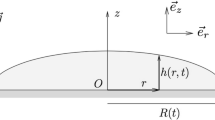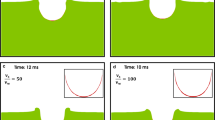Abstract
Spreading of oil on water significantly enhances the water–oil interfacial area. The increase in the interfacial area and the hydrodynamics induced by the viscous oil in the water column underneath the oil affect the dynamics of dissolution of oil in water. The mass transfer dynamics is investigated in the viscous-gravity spreading regime where gravity, promoting spreading, is resisted by the viscous force exerted by the water on the spreading oil. Both unidirectional and axisymmetric spreading cases are considered. A model is developed using an integral boundary layer approach based on fundamentals. The similarity solution provides the time dependent average mass transfer coefficient, concentration boundary layer thickness, and mass transfer coefficient profiles as functions of Schmidt number, geometry and time. Taking into account the typical large oil to water viscosity ratio, the results are discussed based on physical grounds in the light of boundary layer theory to interpret the difference in the asymptotic behavior of the solution near, and sufficiently far from the leading edge of the oil spill.
Article highlights
-
The dynamics of dissolution of oil in water is investigated based on fundamentals taking into account the impact of the oil spreading dynamics on mass transfer.
-
An integral boundary layer approach is adopted to solve the unidirectional and axisymmetric cases using a similarity solution.
-
The time dependent boundary layer thickness and mass transfer coefficient profiles are determined, and the asymptotic behaviors of the solution are discussed based on physical grounds.





Similar content being viewed by others
References
Spaulding ML (2017) State of the art review and future directions in oil spill modeling. Mar Pollut Bull 115:7
Afenyo M, Veitch B, Khan F (2016) A state of the art review of the fate and transport of oil in open and ice covered waters. Ocean Eng 119:233
Fay JA (1969) The spread of oil on a calm sea. Plenum Press, pp 53–64
Hoult DP (1972) Oil spreading on the sea. Annu Rev Fluid Mech 59:341
Chebbi R (2000) Inertia-gravity spreading of oil on water. Chem Eng Sci 55:4953
Chebbi R (2001) Viscous-gravity spreading of oil on water. AIChE J 47:288
Chebbi R (2013) Spreading of steadily-discharged oil on water in the viscous-gravity stage. Chem Eng Sci 98:311
Chebbi R (2014) Spreading of oil on water in the surface-tension regime. Environ Fluid Mech 14:1443
Elbashbeshy EMA, Bazid MAA (2004) Heat transfer over an unsteady stretching surface. Heat Mass Transf 41:1
Yürüsoy M (2006) Unsteady boundary layer flow of power-law fluid on stretching sheet surface. Int J Eng Sci 44:325
Vajravelu K, Cannon JR (2006) Fluid flow over a nonlinearly stretching sheet. Appl Math Comput 181:609
Fang T, Zhang J, Yao S (2010) A new family of unsteady boundary layers over a stretching surface. Appl Math Comput 217:3747
Afzal N (2010) Momentum and thermal boundary layers over a two-dimensional or axisymmetric non-linear stretching surface in a stationary fluid. Int J Heat Mass Transf 53:540
Wang CY (2011) Review of similarity stretching exact solutions of the Navier-Stokes equations. Eur J Mech B/Fluids 30:475
Ashrafi N, Mohamadali M (2014) Transient flow and heat transfer of pseudoplastic fluids on a stretching sheet. Appl Math Comput 228:153
Ahmed N, Umar Khan A, Mohyud-Din ST, Erturk VS (2017) Influence of thermal and concentration gradients on unsteady flow over a stretchable surface. Results Phys 7:3153
Khan KA, Butt AR, Raza N (2018) Effects of heat and mass transfer on unsteady boundary layer flow of a chemical reacting Casson fluid. Results Phys 8:610
Lu CY, Polak J (1973) A study of the solubility of oil in water, Rep. EPS-4-EC-76-1, 25 Environ Prot Serv, Ottawa, Ont, Canada
Mackay D, Leinonen PJ (1977) Mathematical model of the behaviour of oil spills on water with natural and chemical dispersion, prepared for fisheries and environment Canada. Economic and Technical Review Report EPS-3-EC-77-19, 39
Cohen D, Mackay D, Shiu WY (1980) Mass transfer rates between oil slicks and water. Can J Chem Eng 58:569
Shen HT, Yapa PD, Petroski ME (1987) A simulation model for oil slick transport in lakes. Water Resour Res 23:1949
Keramea P, Spanoudaki K, Zodiatis G, Gikas G, Sylaios G (2021) Oil spill modeling: a critical review on current trends, perspectives, and challenges. J Mar Sci Eng 9:181
Gros J, Arey JS, Socolofsky SA, Dissanayake AL (2020) Dynamics of live oil droplets and natural gas bubbles in deep water. Environ Sci Technol 54(19):11865–11875
Cooper C, Adams E, Gros J (2021) An evaluation of models that estimate droplet size from subsurface oil releases. Mar Pollut Bull 163:111932
Buckmaster J (1973) Viscous-gravity spreading of an oil slick. J Fluid Mech 59:481
Bird RB, Stewart WE, Lightfoot EN (2007) Transport phenomena. John Wiley, NY
Acknowledgements
This research was funded by the American University of Sharjah. Grant/Fund Number: FRG19-S-98/EN2006
Author information
Authors and Affiliations
Corresponding author
Ethics declarations
Conflict of interest
The author has no relevant financial and non-financial interests to disclose.
Additional information
Publisher's Note
Springer Nature remains neutral with regard to jurisdictional claims in published maps and institutional affiliations.
Rights and permissions
About this article
Cite this article
Chebbi, R. Dissolution of oil in water in the viscous-gravity stage of oil spreading. Environ Fluid Mech 22, 189–202 (2022). https://doi.org/10.1007/s10652-022-09837-6
Received:
Accepted:
Published:
Issue Date:
DOI: https://doi.org/10.1007/s10652-022-09837-6




